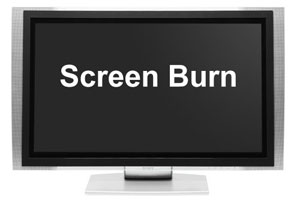Now that we’ve reviewed a couple of plasma TVs back-to-back, it’s probably time to talk about one of the more frequently cited reasons for NOT embracing this display technology – plasma screen burn. First let’s clarify some terminologies:
Image Retention: Temporary ghosting seen due to accumulation of plasma pixel charge after displaying high contrast (white) images for extended periods. The key is that it is transient and can usually be “washed away” by displaying other moving images or turning the plasma TV off overnight.
Screen Burn: Also known as phosphor burn-in, this is permanent ghosting due to uneven phosphor aging. Let’s illustrate with an example… we know that to light up each plasma pixels, gas has to be electrically converted into plasma which then excites the phosphor coating. With each excitation the pixel will lose brightness… the current figure quoted is that a typical plasma TV will lose half its brightness after 60,000 hours of use (that’s 21 years if you watch TV 8 hours a day). Imagine a plasma panel where we continuously run the following image for an extended period, say 6 months:

The pixels which form the phrase “Screen Burn” in white will excite their phosphors more and therefore lose their brightness faster than the black background. After 6 months, you can expect to see the phrase “Screen Burn” on almost any picture that is displayed on the plasma TV because the pixels there are going to be duller than the others, manifesting as screen burn. This is just a rough explanation; in real-life most screen burns are caused by static logos such as Sky, BBC, etc.
To be honest, screen burn on plasma TV is becoming less and less of an issue today, as plasma manufacturers have developed new technologies to tackle the problem. Some pre-burn their plasma panels evenly in the factory before shipping them out to consumers. Some employ motion-adaptive technology to shift the pixels very subtly to the extent that we cannot detect any movement, yet it’s enough to prevent screen burn on plasma TVs. Most newer plasma TVs – certainly both the Panasonic TH42PX70 and Pioneer PDP4270XD – offer grey masking for 4:3 programmes… on the notion that any phosphor excitation in accordance to the moving image in the centre is better than no excitation at all.
That said, it’s better to take precautionary steps during the first 200 hours of a plasma TV’s lifespan when the phosphors are still unstable and burn more intensely, making plasma screen burn a real risk. The most common (and correct) advice is to switch to Cinema mode, lower the brightness and contrast and use the plasma TV normally, taking care not to display static pictures or logos for more than 30 minutes. Also, try to use zoom modes to fill up the 16:9 plasma screen when watching 4:3 programmes or 2.85:1 DVDs… for the first 100 to 200 hours.
However, if you wish to speed up the process, here’s a hardcore method (not for the faint-hearted, but particularly useful when the editorial deadline’s looming around the corner) step-by-step:
The reason this method works is because you are burning the phosphors EVENLY by displaying the same intensity across the whole plasma screen. It is actually taught and endorsed by the Imaging Science Foundation (ISF), you can read about it in this AVSForum thread here.